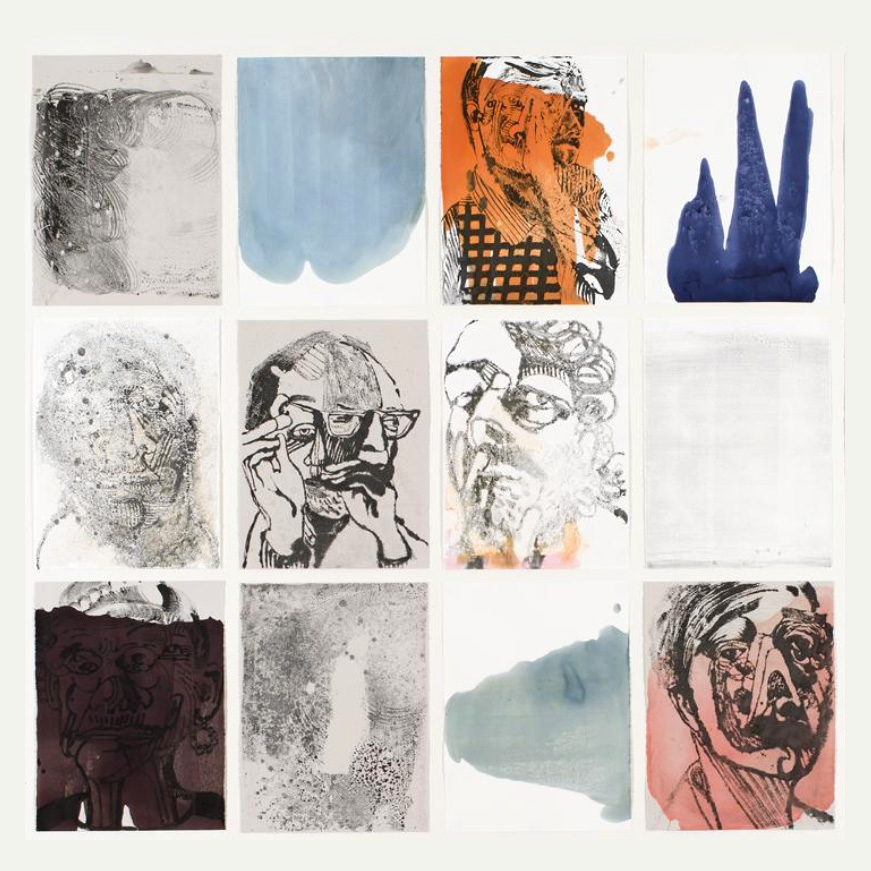
Storm Tharp, Cadre and Wolves at the Door, 2017. Contact-based prints, ink, fabric dye, acrylic paint, charcoal, and spray paint on paper, 30 x 22 in. each.
DORIAN: Rereading Oscar Wilde’s "The Picture of Dorian Gray"
Image Gallery Exhibition FileNovember 3 - December 10, 2017
Authors: Oscar Wilde and Sara Jaffe
Scholars: Jay Dickson, Daniel A. Novak, and Kimberly J. Stern
Oscar Wilde’s 1890 novel The Picture of Dorian Gray is a rare work that chronicles an Orphic descent into art’s symbolic “soul,” examining the nature of human-object relations with fearless imagination and fantasy. Written during the waning of the Victorian era, the novel also presents a morbid case study of “Art for Art’s Sake,” the mantra of Aestheticism, articulated in English by Walter Pater in the late 1860s.
In keeping with Wilde’s philosophical, social, and aesthetic critique, the artists in the exhibition examine art’s capacity to figure and expand the representation and expression of the self—through art, and as art—in response to moral and political issues as critical today as they were in Wilde’s time. The larger exhibition project assembles artists, writers, and scholars for a public conversation with symposium attendees. A commissioned work of fiction by writer Sara Jaffe accompanies the exhibition and will be presented by the author at the symposium.
The first edition of Dorian Gray was published in London in 1890 in Lippincott’s Monthly Magazine. In Victorian England, the work’s “homosexual” narrative caused a swift and angry response—so much so that Wilde was forced to significantly alter the work before it could be released in book form in 1891. Eventually, the novel was used against Wilde during two of his three trials for “gross indecency.” On May 25, 1895 Wilde was convicted and sentenced to two years of hard labor at Reading Gaol, where he wrote one of his greatest works—De Profundis—an epistolary reflection on his relationship with Lord Alfred Douglas. Weakened by prison and penniless, Wilde died of meningitis in 1900 at forty-six, a victim of social and legal prejudice.
The Picture of Dorian Gray’s titular protagonist is a bewitching young Londoner who sits for a portrait by artist Basil Hayward. The completed painting is deemed a “masterpiece” by Hayward and his friend Lord Henry Wotton—a wealthy and narcissistic aesthete. Under Wotton’s corrupting influence, Dorian begins to covet his portrait’s arrested vision of youthful beauty and charisma. In a fit of despair Dorian implores: “. . . I shall grow old and horrid and dreadful . . . if it was only the other way! If it was I who were to be always young, and the picture that were to grow old! For this I would give everything!” Mysteriously, Dorian’s wish comes true, and under the influence of Wotton, his life turns to hedonism. As Dorian’s behavior becomes increasingly violent and sadistic—breaking hearts, committing murder—the portrait transforms into a supernatural phantasm, bloodied and smirking in disgust. Dorian confines the portrait to his attic, obsessed with its presence and consumed by fits of guilt. Dorian destroys his debased image by slicing it with a knife, assuming that it is the work of art that must pay for his inhumanity through an act of iconoclasm. But it’s Dorian who dies from the painting’s wounds, and as he dies, the portrait returns to its original beauty having shed its human baggage.
During the Cooley’s November 4th symposium, Portland-based artist Storm Tharp and writer Sara Jaffe will present their work alongside: Eve Fowler, Los Angeles-based artist; Daniel A. Novak, Associate Professor of English, University of Mississippi; and Kimberly J. Stern, Assistant Professor of English and Comparative Literature, University of North Carolina at Chapel Hill. The symposium is organized by Jay Dickson, Professor of English and Humanities, Reed College; and Stephanie Snyder, Director and Curator, Douglas F. Cooley Memorial Art Gallery, Reed College. The symposium is generously supported by the Department of English, and the Office of the Dean of Faculty. Dorian is curated by Stephanie Snyder.